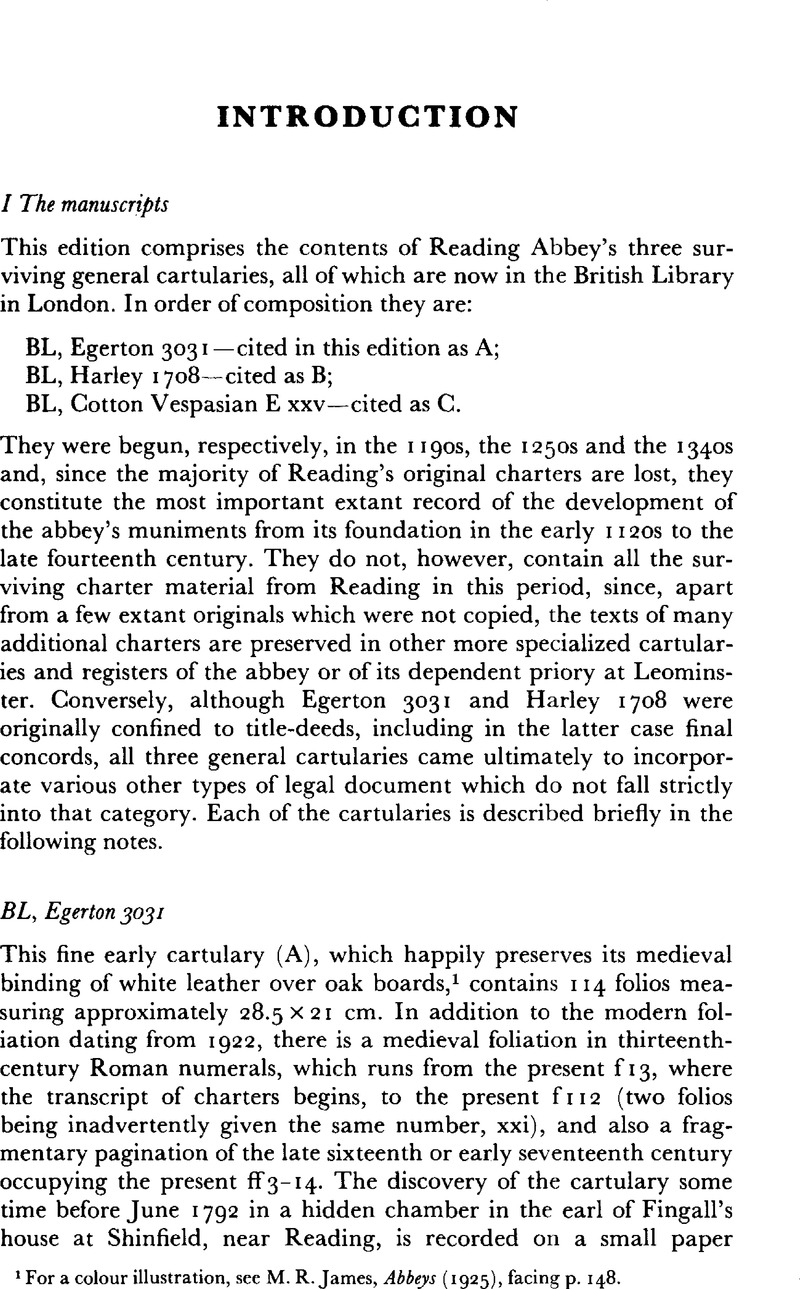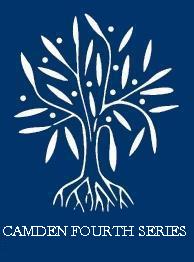No CrossRef data available.
Article contents
I The manuscripts
Published online by Cambridge University Press: 21 December 2009
Abstract

- Type
- Introduction
- Information
- Copyright
- Copyright © Royal Historical Society 1986
References
page 1 note 1 For a colour illustration, see James, M. R., Abbeys (1925)Google Scholar, facing p. 148.
page 2 note 1 The paper is numbered i. The account reads:
‘This book of the charters of Reading Abbey was found secreted in a very concealed & unknown corner in my Lord Fingall's house at Shinefield near Reading, it was brought to Woolhampton great house, now Mrs [sic] Crew's, by Gul. Corderoy the steward with several other books, found by a bricklayer necessitated to pull some part of the house or rather part of a wall down in order to repair thoroughly a chimney in Shinefield House. This account I had from the forementioned Mr Corderoy on Wednesday the twenteth of June 1792 who likewise supposes the bricklayer who is now living at Reading found no small sum of money, or something valuable as shortly after that time, he advanced much in the world, by means of money [f i (v)] which no one knows how he could be worth. Wrote this account—on June 23d. 1792.
N.B. Mr Corderoy told me that in this concealed place there was convenient room for three persons there being three seats.’
A slightly shorter version of this account is in BL Additional Ms 37130 f37v, where Woolhampton great house is said to be ‘now Mr Crew's.’
page 2 note 2 BL Add. Ms 37130 f 37r.
page 2 note 3 For these items, apart from the table of contents, see below, nos. 225–8, 221–2. For a colour reproduction of the opening of the list of books at Reading (f8v), see James, , Abbeys, facing p. 82.Google Scholar
page 3 note 1 Nos. 155, 673, 1198.
page 3 note 2 Nos. 204–5.
page 3 note 3 No. 206.
page 3 note 4 Nos. 38, 483.
page 4 ntoe 1 Nos. 69, 790, 859.
page 4 note 2 No. 791. The date cannot be established with certainty, since the plea roll containing this case does not survive.
page 4 note 3 They are: (1) a memorandum concerning Abbot Anscher's foundation of the leper house (no. 221); (2) an ordinance defining punishments for offending lepers (no. 222); (3) Henry III's charter of disafforestation in Berkshire in 1227 (no. 1306); and (4) a notification of the induction of Reading Abbey into the church of Bucklebury in 1239 (no. 700). Henry III's charter is the one which is entered in the second main hand of Cotton Vesp. E xxv.
page 5 note 1 The modern foliation in pencil dates from April 1872, but it omits from the sequence two entirely blank folios which occur, respectively, after f 187 and after f 226.
page 5 note 2 The break is caused by the subsequent loss of five folios after the present f200 (see below).
page 5 note 3 No. 635.
page 5 note 4 For a specimen, see New Pal. Sac. Focs., 1st ser., pl. 87, which reproduces f 47r.
page 6 note 1 The four initials occur at the beginning of the following groups of charters: Henry II's (f21r), John's (f33r), Henry III's (f36r), and Berkshire charters (f47r), for the last of which see the preceding note. It may be significant that the cartulary chose in this way to distinguish the charters of Henry II, whose long reign brought the abbey several royal acts, of John, who maintained exceptionally good relations with the monks, and of Henry III, in whose reign the cartulary was written.
page 6 note 2 No. 1128.
page 6 note 3 No. 648.
page 6 note 4 No. 640.
page 7 note 1 Nos. 114–16.
page 7 note 2 No. 117.
page 7 note 3 Nos. 51–2. See Stenton, , English Justice, 105.Google Scholar
page 7 note 4 No. 53.
page 7 note 5 Nos. 123–4.
page 8 note 1 Nos. 1312–14.
page 8 note 2 No. 234.
page 8 note 3 See, e.g., Davis, G. R. C., Medieval Cartularies of Great Britain (1958), 91.Google Scholar
page 8 note 4 These are as follows: (i) four Sussex charters, which appear on Harley 1708 ff 109r–110r in the order 1,2,3,4 (below, nos. 556, 553, 555, 557), are listed on the roll in the order 1,4,2,3; (ii) two charters on f 111v relating to the Turville gift in London (below, nos. 460–1) are listed in reverse order; and (iii) two writs of Eleanor of Aquitaine on f 113v concerning London properties (below, nos. 466–7) are listed in reverse order.
page 8 note 5 Both are listed under Rowington (Warks.): (i) Carta Hugonis de Boddebroc facta Waltero de Ruzerwik de una assarta in Screvele [Shrewley]; (ii) Cyr(ographum) de terra quam Symon clericus de Rokinton' tenuit. Vacat. For neither of these items does the roll attempt to provide a folio reference in the cartulary.
page 8 note 6 See below, no. 618a.
page 9 note 1 See above and no. 648.
page 9 note 2 See below, nos. 589, 586.
page 9 note 3 No. 578a.
page 9 note 4 The charter concerned is Hugh of Kilpeck's quitclaim of Broadward (Herefs.). The rubric in Harley 1708 and the item in Add. Roll 19617 read: Carta Hugonis de Kilpeec [Kilpec in the roll] de quietaclamantia de Bradeford'; the endorsement which the charter bore in the 13th century reads: Hugo de Clipeet de Brad' (see below, no. 327).
page 9 note 5 On this point in general, see Walker, D., ‘The organization of material in medieval cartularies’ in The Study of Medieval Records, ed. Bullough, D. A. and Storey, R. L. (Oxford, 1971), 139–43.Google Scholar
page 10 note 1 These are: one after the present f 1, one after f 152 (omitted also in the Arabic sequence, for which see below), two after faig (originally included in the Arabic sequence, although the former top corners of the folios bearing the numerals are lost), three after f 223 (where the Arabic foliation ends) and one after f 230. On the other hand, a number of folios had been lost from the cartulary before the current foliation was supplied (see below, p. 13 n. 1).
page 10 note 2 No. 217.
page 10 note 3 The only exception is a gap left before the beginning of Richard I's charters in the royal section.
page 10 note 4 No. 13.
page 10 note 5 No. 686.
page 10 note 6 Apart from the founder's charters, these include charters of the Empress Matilda, Queen Adeliza and Henry II (both as duke and as king) as well as many of Stephen's.
page 10 note 7 It presumably would not have included the royal and judicial material entered on the present ff 4r–15v of Harley 1708 (see above).
page 11 note 1 No. 112.
page 11 note 2 Nos. 637, 1196.
page 11 note 3 Nos. 1265–6.
page 12 note 1 No. 943.
page 12 note 2 Nos. 1026–7, 1034–8.
page 12 note 3 No. 154.
page 13 note 1 Parts of the medieval Arabic sequence are missing, indicating losses of folios since it was provided, namely, the numerals 145 (after the present f 150), either 149 or 150 (after f 153), 153–156 (after f 156), and 158–163 (after f 157). In the last case physical evidence remains of the removal of some folios after the present f 157, which bears also the medieval Arabic numeral 157.


